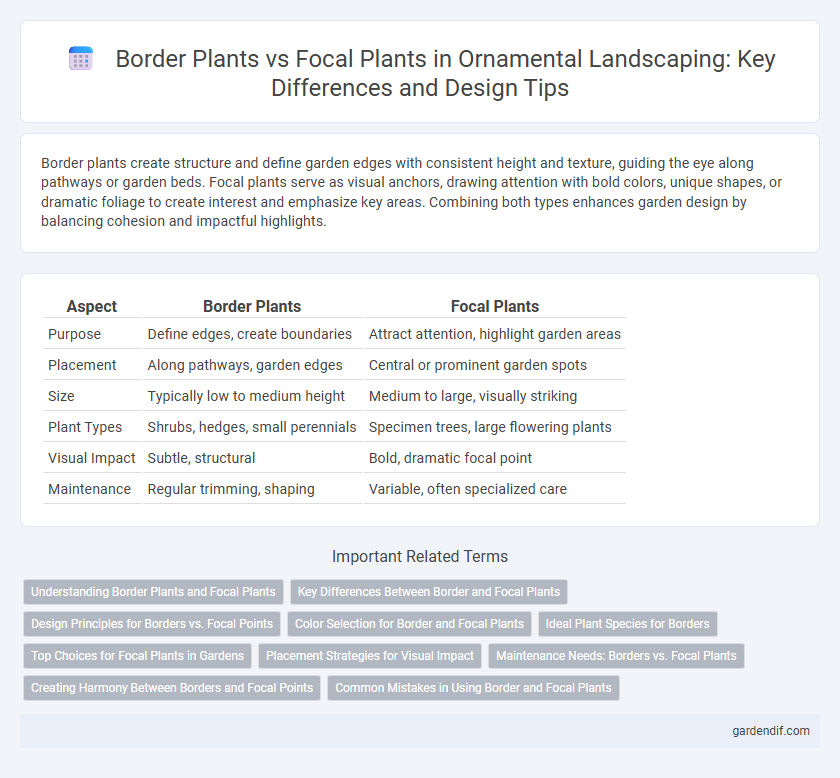
Border Plants vs Focal Plants Illustration
Border plants create structure and define garden edges with consistent height and texture, guiding the eye along pathways or garden beds. Focal plants serve as visual anchors, drawing attention with bold colors, unique shapes, or dramatic foliage to create interest and emphasize key areas. Combining both types enhances garden design by balancing cohesion and impactful highlights.
Table of Comparison
| Aspect | Border Plants | Focal Plants |
|---|---|---|
| Purpose | Define edges, create boundaries | Attract attention, highlight garden areas |
| Placement | Along pathways, garden edges | Central or prominent garden spots |
| Size | Typically low to medium height | Medium to large, visually striking |
| Plant Types | Shrubs, hedges, small perennials | Specimen trees, large flowering plants |
| Visual Impact | Subtle, structural | Bold, dramatic focal point |
| Maintenance | Regular trimming, shaping | Variable, often specialized care |
Understanding Border Plants and Focal Plants
Border plants create structure and define garden edges with consistent height and texture, guiding the eye and complementing focal plants. Focal plants serve as visual anchors by showcasing unique colors, shapes, or sizes that draw immediate attention within the landscape. Understanding the roles of both plant types enhances garden design through balanced contrast and harmonious composition.
Key Differences Between Border and Focal Plants
Border plants are typically low-growing and planted along edges to define garden boundaries, offering consistent structure and subtle texture. Focal plants draw attention as centerpiece elements with their height, bold colors, or unique forms, creating visual interest and focal points in garden design. Key differences include placement, size, and purpose: border plants enhance garden layout continuity, while focal plants serve as standout attractions.
Design Principles for Borders vs. Focal Points
Border plants emphasize repetitive patterns and consistent height to create structured edges that guide the viewer's eye along pathways or garden perimeters. Focal plants feature unique forms, vibrant colors, or striking textures to draw immediate attention and anchor the overall landscape composition. Effective design balances the rhythm established by border plants with the visual impact of focal points to enhance spatial depth and aesthetic harmony.
Color Selection for Border and Focal Plants
Color selection for border plants emphasizes consistent, complementary hues to create a harmonious frame that enhances garden structure and guides the eye. Focal plants demand bold, vibrant colors or striking contrasts to capture attention and serve as visual anchors within the landscape. Strategic use of contrasting and complementary color palettes in borders and focal points maximizes visual interest and dynamic garden composition.
Ideal Plant Species for Borders
Ideal plant species for borders include lavender, boxwood, and hostas, which provide structure and continuity along garden edges. These plants offer uniform height and dense foliage, creating a defined frame that enhances the visual appeal of focal plants. Effective border plants also thrive in various soil types and require minimal maintenance, ensuring long-lasting, attractive garden boundaries.
Top Choices for Focal Plants in Gardens
Top choices for focal plants in gardens include specimens with striking form, vibrant colors, and unique textures such as Japanese Maple (Acer palmatum), hydrangeas (Hydrangea macrophylla), and ornamental grasses like Miscanthus sinensis. These plants create visual interest by drawing the eye and providing structure, often used at the center or key points of garden design. Selecting focal plants with seasonal appeal and contrasting foliage enhances garden aesthetics and ensures year-round attention.
Placement Strategies for Visual Impact
Border plants are strategically placed along garden edges to create structured outlines and enhance spatial depth, using species like lavender or boxwood for consistent texture and color. Focal plants, such as Japanese maples or flowering magnolias, are positioned centrally or at key viewing points to draw attention and serve as visual anchors. Effective placement prioritizes contrast in height, color, and form, ensuring border plants frame focal points and guide the eye for maximum garden impact.
Maintenance Needs: Borders vs. Focal Plants
Border plants typically require consistent trimming and regular watering to maintain their structured appearance, which helps define garden edges effectively. Focal plants often demand more specialized care, including pruning techniques that promote healthy growth and enhance their standout features. Proper maintenance of both plant types ensures longevity and visual balance in ornamental landscaping.
Creating Harmony Between Borders and Focal Points
Border plants frame garden edges with uniform height and texture, guiding the eye toward focal plants that serve as visual anchors through bold color or unique form. Selecting complementary species ensures a seamless transition, balancing contrast and continuity to enhance overall garden cohesion. Strategic layering and spacing promote harmony, allowing focal points to stand out while border plants support the composition without overpowering it.
Common Mistakes in Using Border and Focal Plants
Common mistakes in using border and focal plants include overcrowding border plants, which limits airflow and hinders growth, and incorrectly sizing focal plants, causing imbalance in garden design. Using too many focal plants dilutes their impact, while placing border plants too close to pathways can obstruct movement. Choosing inappropriate plant varieties for specific climates or soil types often leads to poor health and reduced aesthetic appeal in both border and focal roles.
Border Plants vs Focal Plants Infographic

 gardendif.com
gardendif.com